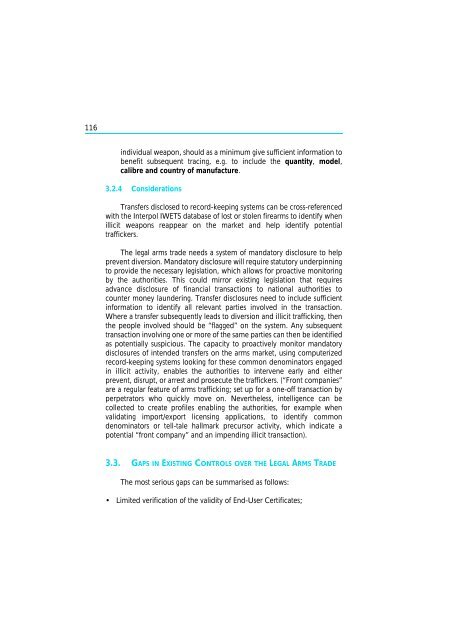The Scope and Implications of a Tracing Mechanism for Small Arms ...
The Scope and Implications of a Tracing Mechanism for Small Arms ...
The Scope and Implications of a Tracing Mechanism for Small Arms ...
You also want an ePaper? Increase the reach of your titles
YUMPU automatically turns print PDFs into web optimized ePapers that Google loves.
116<br />
individual weapon, should as a minimum give sufficient in<strong>for</strong>mation to<br />
benefit subsequent tracing, e.g. to include the quantity, model,<br />
calibre <strong>and</strong> country <strong>of</strong> manufacture.<br />
3.2.4 Considerations<br />
Transfers disclosed to record-keeping systems can be cross-referenced<br />
with the Interpol IWETS database <strong>of</strong> lost or stolen firearms to identify when<br />
illicit weapons reappear on the market <strong>and</strong> help identify potential<br />
traffickers.<br />
<strong>The</strong> legal arms trade needs a system <strong>of</strong> m<strong>and</strong>atory disclosure to help<br />
prevent diversion. M<strong>and</strong>atory disclosure will require statutory underpinning<br />
to provide the necessary legislation, which allows <strong>for</strong> proactive monitoring<br />
by the authorities. This could mirror existing legislation that requires<br />
advance disclosure <strong>of</strong> financial transactions to national authorities to<br />
counter money laundering. Transfer disclosures need to include sufficient<br />
in<strong>for</strong>mation to identify all relevant parties involved in the transaction.<br />
Where a transfer subsequently leads to diversion <strong>and</strong> illicit trafficking, then<br />
the people involved should be “flagged” on the system. Any subsequent<br />
transaction involving one or more <strong>of</strong> the same parties can then be identified<br />
as potentially suspicious. <strong>The</strong> capacity to proactively monitor m<strong>and</strong>atory<br />
disclosures <strong>of</strong> intended transfers on the arms market, using computerized<br />
record-keeping systems looking <strong>for</strong> these common denominators engaged<br />
in illicit activity, enables the authorities to intervene early <strong>and</strong> either<br />
prevent, disrupt, or arrest <strong>and</strong> prosecute the traffickers. (“Front companies”<br />
are a regular feature <strong>of</strong> arms trafficking; set up <strong>for</strong> a one-<strong>of</strong>f transaction by<br />
perpetrators who quickly move on. Nevertheless, intelligence can be<br />
collected to create pr<strong>of</strong>iles enabling the authorities, <strong>for</strong> example when<br />
validating import/export licensing applications, to identify common<br />
denominators or tell-tale hallmark precursor activity, which indicate a<br />
potential “front company” <strong>and</strong> an impending illicit transaction).<br />
3.3. GAPS IN EXISTING CONTROLS OVER THE LEGAL ARMS TRADE<br />
<strong>The</strong> most serious gaps can be summarised as follows:<br />
• Limited verification <strong>of</strong> the validity <strong>of</strong> End-User Certificates;
















